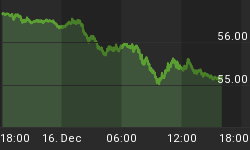Below is an extract from a commentary originally posted at www.speculative-investor.com on 23rd June 2005.
In our 14th March commentary, under the heading "High-Confidence Views", we wrote the following.
"The 12-month forecasts we can make with the greatest amount of confidence are, in no particular order:
a) The US$ will rise relative to the other major fiat currencies
b) Gold will rise relative to oil and the industrial metals
c) There will be a pronounced shift away from risk"
We then went on to explain the reasoning behind each of these views.
At this stage there is evidence that the first of the above forecasts is on the right track, although it's way too early to tick it off as being complete because our expectation is for a lot more dollar strength over the coming year and because the bulk of the recent rally in the dollar has been relative to the euro (our forecast is for a large rise in the US$ relative to ALL major fiat currencies, not just the ones in Europe).
The third of the above forecasts got off to a good start because there was a definite shift away from risk during March and April, but market participants appear to have become emboldened again over the past 6 weeks. Therefore, it's also still early days as far as this high-confidence view is concerned.
But what we want to focus on today is the second of the above 12-month forecasts; in particular, our expectation that gold will rise relative to oil. The short-term price action is clearly yet to provide any support to this longer-term outlook, but we are no less confident in this view than we are in either of the other two. In fact, all three forecasts are inter-related since rising US interest rates combined with a contraction in global liquidity will likely result in a higher US$, a shift away from riskier investments, and, later on, strength in gold relative to almost everything -- oil included -- as central banks begin to fight the liquidity contraction.
As intimated in the above paragraph, significant strength in gold relative to cyclical commodities such as oil isn't likely to occur until after there are enough obvious economic/financial problems in the world for the markets to begin anticipating the next round of central-bank-sponsored inflation. As things currently stand, however, the financial markets appear to be anticipating a fairly benign outcome encompassing a modest slowing of growth in the US and Europe (certainly not a recession), no major tightening of credit conditions, and Asia continuing to power ahead. Hence the rebound in growth-oriented investments that has occurred since the beginning of May. Needless to say, we aren't anticipating such a benign outcome. Specifically, we expect that a) recessions will occur in the US and the largest countries of Europe during 2006, b) it will become considerably more difficult to obtain credit, and c) there will be a pronounced slowdown in Asia's economic growth over the coming year.
In addition to our expectation that the economic backdrop is going to become progressively more bullish for gold and less bullish for oil (and other cyclical commodities), there are valuation- and sentiment-related reasons to anticipate substantial out-performance by gold over the coming 12-18 months. From a relative valuation perspective, for instance, the below chart shows that the gold/oil ratio is currently testing the 20-year low reached in September of 2000. In fact, over the past 35 years the only time the gold/oil ratio has been lower than it is right now was during the second half of 1976 -- just prior to the start of a phenomenally bullish 3-year period for gold.

From a sentiment perspective, there appears to be almost universal bullishness towards oil at this time. Whenever the Wall St financial houses issue their price forecasts for oil they almost always under-estimate, but we get the impression that most investors stopped listening to these self-serving forecasts long ago. In particular, the bullish case for oil is very widely understood and gets repeated ad nauseam in the mainstream press. However, hardly anyone understands the bullish case for gold. Even many of those who describe themselves as gold bulls cite spurious reasons for their bullishness, such as "there's a big deficit between fabrication demand and new mine supply" and "the gold price has been artificially suppressed for so long that it's bound to rocket higher regardless of what happens in other markets" and "gold is a great hedge against deflation".
Under the current monetary system gold bull markets are all about confidence in central banks, in paper currencies, and in financial assets (stocks and bonds). When confidence is in a long-term downward trend then gold will be in a bull market and when confidence is in a long-term upward trend gold will be in a bear market. End of story. The challenge is that it's often not easy to anticipate the confidence trend, or even to identify it while it is still in its early stages.
The point is, when a bullish story is very widely known it is reasonable to assume that it is mostly factored into current market prices. Also, a widespread appreciation of the bullish case tends to only occur during the latter stages of a bull market. On the other hand, if only a relatively small number of people understand the fundamental forces that are driving the price higher then it is generally safe to assume that the bull market is in its infancy.
















